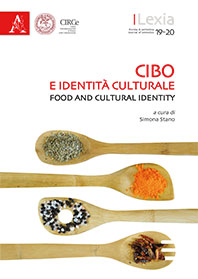Estratto da
LEXIA. RIVISTA DI SEMIOTICA
Cibo e identità culturale | Food and Cultural Identity
New Meat and the Media Conundrum with Nature and Culture
LEXIA. RIVISTA DI SEMIOTICA
Cibo e identità culturale | Food and Cultural Identity
New Meat and the Media Conundrum with Nature and Culture

ITALIAN TITLE: I nuovi tipi di carne e l’indecisione dei media sul rapporto tra Natura e Cultura
ABSTRACT: “New meat” is meat obtained either from stem cells or totally synthetically, and promises to drastically reduce pollution and to abolish animal killing, despite raising safety issues. This study analyses how the media have been constructing “new meat” since 2012, the year of the first test–tube hamburger. Peirce (1877) finds four different ways through which people accept new beliefs; they are based either on past models, or on power and economic interests, or on individual accommodation, or on science. Moreover, new meat is a human artefact that aims to replace a natural product, and therefore it raises foundational issues linked to the relationships between Nature and Culture.While old theories see these two concepts as separate and conflicting, this work builds on newer, bio–semiotic perspectives according to which the two concepts are linked to each other by mutual and ever changing relationships. Articles published in online versions of British and American magazines, newspapers and broadcasters have been purposely sampled and semiotically analysed. The results show that the media represent new meat either as a utopian product able to clean the world of evil (pollution, illness, animal suffering, etc.), or as a dystopian food, similar to GM products and continuing the long list of dangerous techno–foods. The utopian representations adopt Peirce’s power–led fixation of belief; instead, the dystopians rely on Peirce’s a priori method. Thus, Nature and Culture are still considered as two separate entities in conflict with each other. However, further semiotic analysis of the forms and names that scientists and designers are giving to new meat demonstrate that the new perspectives on Nature and Culture as interacting are slowly entering the field. In conclusion, the newer approach to Nature and Culture is more practiced by scientists and designers, while the media lag behind, still anchored to old schemes.
KEYWORDS: food semiotics; cultured meat; nature and culture; in–vitro meat; Peirce.
ABSTRACT: “New meat” is meat obtained either from stem cells or totally synthetically, and promises to drastically reduce pollution and to abolish animal killing, despite raising safety issues. This study analyses how the media have been constructing “new meat” since 2012, the year of the first test–tube hamburger. Peirce (1877) finds four different ways through which people accept new beliefs; they are based either on past models, or on power and economic interests, or on individual accommodation, or on science. Moreover, new meat is a human artefact that aims to replace a natural product, and therefore it raises foundational issues linked to the relationships between Nature and Culture.While old theories see these two concepts as separate and conflicting, this work builds on newer, bio–semiotic perspectives according to which the two concepts are linked to each other by mutual and ever changing relationships. Articles published in online versions of British and American magazines, newspapers and broadcasters have been purposely sampled and semiotically analysed. The results show that the media represent new meat either as a utopian product able to clean the world of evil (pollution, illness, animal suffering, etc.), or as a dystopian food, similar to GM products and continuing the long list of dangerous techno–foods. The utopian representations adopt Peirce’s power–led fixation of belief; instead, the dystopians rely on Peirce’s a priori method. Thus, Nature and Culture are still considered as two separate entities in conflict with each other. However, further semiotic analysis of the forms and names that scientists and designers are giving to new meat demonstrate that the new perspectives on Nature and Culture as interacting are slowly entering the field. In conclusion, the newer approach to Nature and Culture is more practiced by scientists and designers, while the media lag behind, still anchored to old schemes.
KEYWORDS: food semiotics; cultured meat; nature and culture; in–vitro meat; Peirce.
| pagine: | 419-434 |
| DOI: | 10.4399/978885488571426 |
| data pubblicazione: | Giugno 2015 |
| editore: | Aracne |








